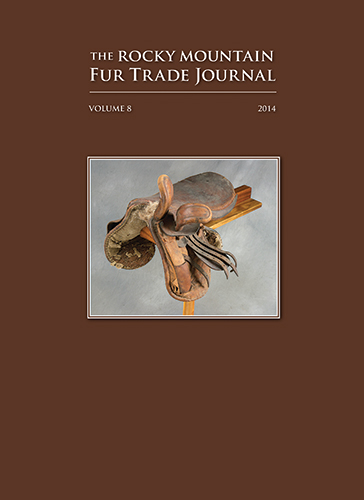$19.95
2014 Rocky Mountain Fur Trade Journal, Volume 8
An annual academic peer-reviewed publication intended to further the knowledge and discussion of the Rocky Mountain fur trade era and provide an avenue for researchers to showcase their work.
Full color, perfect bound, 8″ x 11″, softback, 148 pages
ISSN: 1937-0733
Journal is provided FREE with a purchase of an annual membership!!! Click here to purchase a membership now!
Description
2014 Rocky Mountain Fur Trade Journal, Volume 8
William H. Ashley’s Newly Discovered 1826 Fur Trade Journal
by Dr. Jay H. Buckley
Describes how the diary was found and eventually made its way into the archives of the Campbell House Museum in St. Louis Museum. Includes the complete diary with transcriptions.
1836 and 1838: When White Girls Crashed the Party
by Jill R. Ottman
Conveys thought-provoking observations about the impact the presence of these women had on the rendezvous they attended. Their detailed descriptions in letters and diaries allow historians a female perspective on a culturally mixed but male-dominated event.
Smith, Jackson & Sublette: A Difficult Partnership
by John C. Jackson
A challenge to the accepted viewpoints regarding the business dealings of the three men, providing a particularly critical assessment of Jedediah Smith’s contribution to the enterprise. Drawing from many sources, including some seen here for the first time, Jackson questions whether this early trapper was an asset or a liability to the partnership.
The Blackfoot Road to Plunder
by Paul M. Raczka
An explanation of the Blackfoot tribe’s migration and trade routes that took them north and south along the Rocky Mountain Range from Alberta, Canada to Santa Fe, New Mexico. An interpretation of an 1801 map drawn by Blackfoot chief Old Swan for HBC fur trader Peter Fidler, showing many landmarks that are still observable in modern times.
Jedediah Smith’s Disaster at Defeat River
by James C. Auld
Auld examines the exploits of Jedediah Smith, setting out to identify the location of a fatal encounter between Smith’s party and local Native Americans on the banks of the Umpqua River in 1828. He looks at clues found in first-hand reports as well as an on-the-ground search for further hints that help pinpoint the site of Smith’s camp that was overrun by Kelawatset Indians leaving few survivors.
Sublette County Historical Society, 2014
Additional information
| Dimensions | 11 × 8 × 1.25 in |
|---|

